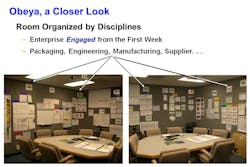While Lean principles have been known and applied in a variety of manufacturing processes, the applications in product development have been slower to come. Several companies have also applied Lean to office processes and done some value stream mapping to attack wastes in a few ancillary development processes such as drawing releases, change orders and prototypes and have seen some improvements. However, most companies are missing the great opportunities that exist to improve their product development value stream. In fact, for most products, 65-75% of the total cost of the product is determined before it even gets to the factory.
Lean product development (Lean PD) is about eliminating waste not just in development processes but across the enterprise. If the principles of Lean PD are applied well, they can also help in adding more value to products for the customer, increasing the competitiveness of the firm.
Some of the key principles of Lean Product Development include:
- Clearly defining customer value to ensure it is delivered while striving to eliminate waste in all other parts of the product and process and keeping these requirements constantly in front of the development team.
- Front-loading the PD process to thoroughly explore the design space using methods such as set-based design.
- Creating leveled flow in the development process.
- Using standardization to drive flexibility by reusing knowledge—best practices, modularity, component reuse, standard processes.
- A Chief Engineer System that has a strong system integrator who can connect understanding customer requirements to product delivery in the market.
- Developing towering technical competency in all our associates.
- Creating a culture that drives learning and continuous improvement.
- Using simple, effective visual management tools in a big room (Obeya) to manage projects.
- Using A3 thinking to proactively solve problems.
Notice these principles go beyond running events to “lean out the process.” There is significant infrastructure that is necessary to develop the high level of competence needed, to develop standards that make sense, and to capture learning in know-how databases. By applying these principles, we have seen companies benefit in improved product quality, lower total product costs, lower development costs and faster time-to-market. For example, one company piloted some of the above principles on one of their key projects and was able to reduce the project time from 24 to 16 months, with less than half the engineering changes, while meeting their quality and cost goals.
Over the last 10 years, I have worked with several companies in a variety of industries applying Lean to product development including Northrop Grumman, Tenneco, Johnson Controls, Harley-Davidson, Schlumberger, PSA, Embraer and Moen. Each of these companies started and have continued their Lean journeys taking different paths depending on the customer needs of their industries and the wastes they encountered internally. That being said, how can you get started on your own Lean journey in product development?
Here are few steps I suggest:
1. Learn the Lean Product Development principles in more depth. Not to be self-serving, but having an experienced coach makes a large difference. You can understand the concepts by reading The Toyota Product Development System by Jim Morgan and Jeff Liker. It is the most comprehensive book covering Lean PD as a system.
2. Select a pilot project. It should be a project that is representative of the types of projects you do today and will have a noticeable impact on the organization. It should also have a core team with a strong leader who are willing to learn and experiment with Lean PD.
3. Conduct a value stream mapping session on the entire project.
- Select a similar past project, if possible, to understand the current state of your product development process.
- Based on the wastes/opportunities found in the current state map, identify the Lean PD principles and practices that will best address the root cause of the issues found.
- Draw the future state map incorporating the Lean PD practices. This will become the high level project plan for the pilot project.
- Create the action plan to ensure that the pilot project will be able to implement the Lean PD practices at the right time during their project.
4. Implement visual management with the project team. The Obeya (big room) is a proven way to visualize the project flow, visualize the product maturity and highlight issues. Teams conduct standup meetings by “walking the walls” periodically and use it the rest of the time as a home room to collaborate and solve problems.
5. Apply A3 thinking. As issues arise during the project, either via the Obeya or other means, this should spur the PDCA cycle. The best way for teams to do this is using A3 problem solving.
Starting with the five steps above, you should get a good start on your lean journey in product development. Best of luck to you all.
_______________________________________
Liker Leadership Institute (LLI) offers an innovative way to learn the secrets of lean leadership through an online education model that is itself lean, and extends that lean education far beyond the course materials. Learn more about LLI's green belt and yellow belt courses in “The Toyota Way to Lean Leadership” and “Principles of Lean Thinking” at the IndustryWeek Store.





